International Marketing Plan: M&S Expansion into Asian Markets
VerifiedAdded on 2023/06/13
|29
|6209
|197
Report
AI Summary
This report provides a comprehensive analysis of Marks & Spencer's (M&S) strategic marketing plan for expanding into the Asian market, specifically focusing on Myanmar, following Brexit. It outlines SMART international marketing objectives, including growth in market share, increased sales, enhanced brand awareness, targeting new customers, and ensuring cost control. The report identifies and evaluates market entry modes, ultimately recommending a franchise model to secure a competitive advantage through cost leadership, differentiation, and focus strategies. It also discusses potential market segmentation, targeting sophisticated middle and upper-middle-class consumers, and establishes branding and positioning strategies for M&S in the new cross-cultural setting. Effective marketing mix decisions related to product, price, place, and promotion are justified to reach the target customer segment and achieve branding goals. The report concludes with recommendations for successful implementation and achieving sustainable growth in the Asian market. Desklib provides access to this and other solved assignments to aid students.
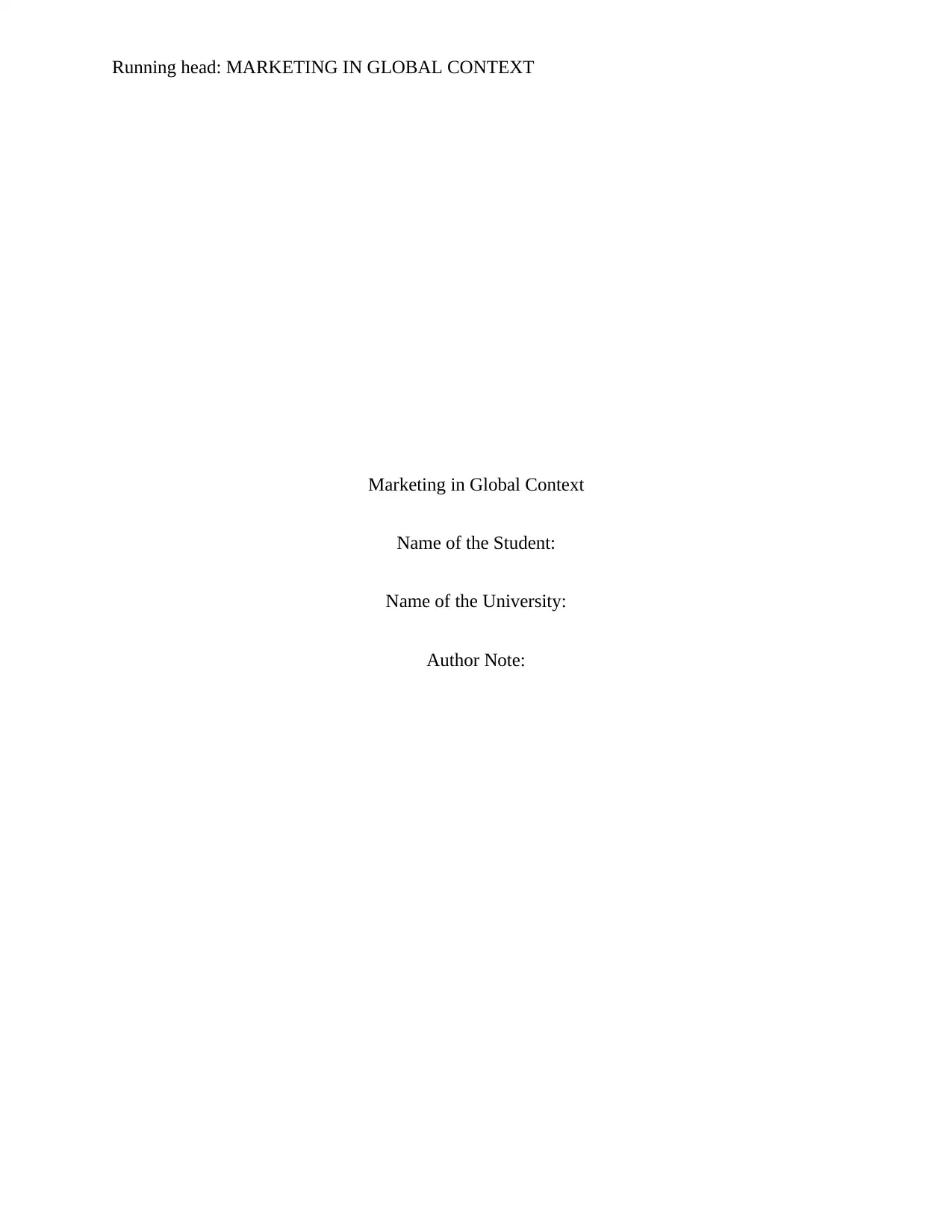
Running head: MARKETING IN GLOBAL CONTEXT
Marketing in Global Context
Name of the Student:
Name of the University:
Author Note:
Marketing in Global Context
Name of the Student:
Name of the University:
Author Note:
Paraphrase This Document
Need a fresh take? Get an instant paraphrase of this document with our AI Paraphraser
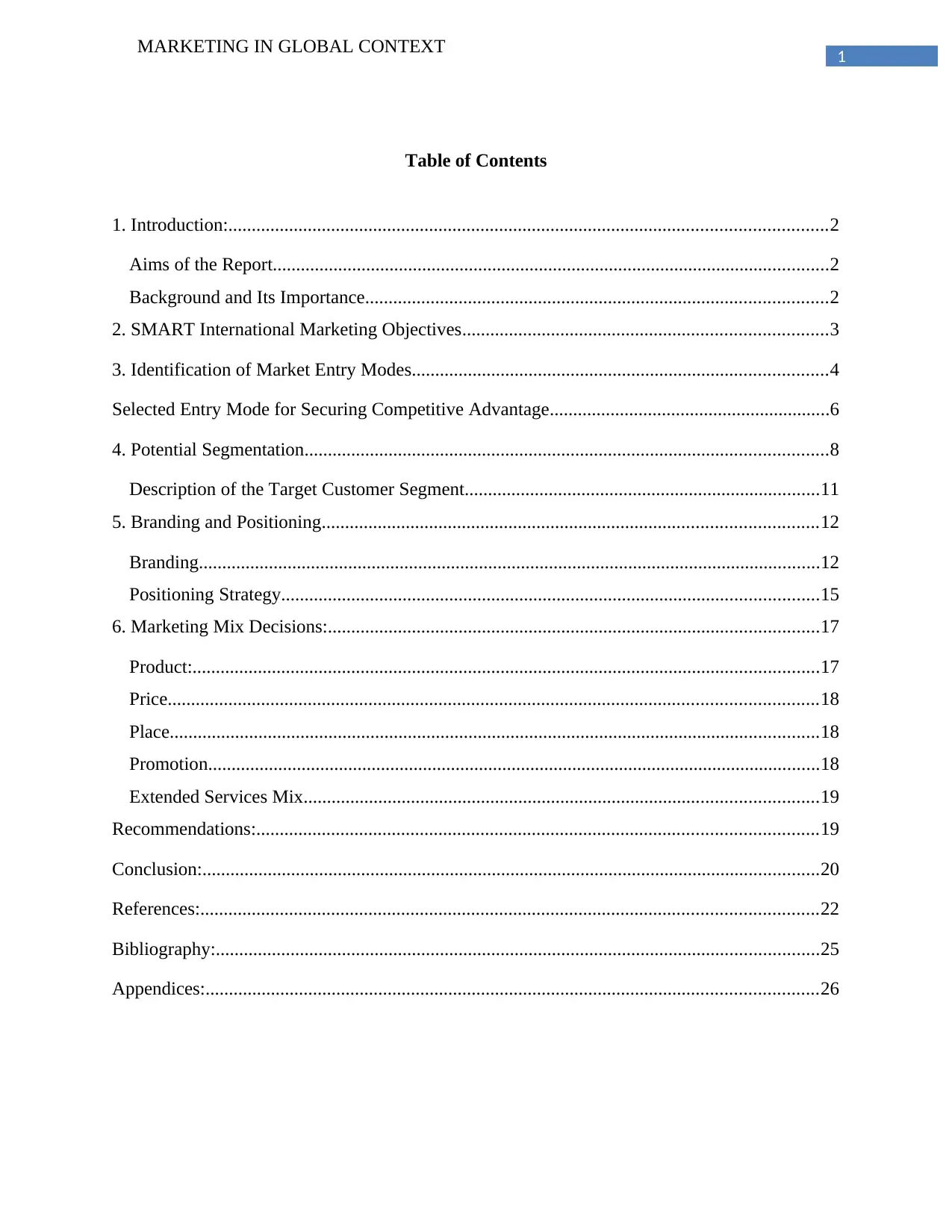
1
MARKETING IN GLOBAL CONTEXT
Table of Contents
1. Introduction:................................................................................................................................2
Aims of the Report.......................................................................................................................2
Background and Its Importance...................................................................................................2
2. SMART International Marketing Objectives..............................................................................3
3. Identification of Market Entry Modes.........................................................................................4
Selected Entry Mode for Securing Competitive Advantage............................................................6
4. Potential Segmentation................................................................................................................8
Description of the Target Customer Segment............................................................................11
5. Branding and Positioning..........................................................................................................12
Branding.....................................................................................................................................12
Positioning Strategy...................................................................................................................15
6. Marketing Mix Decisions:.........................................................................................................17
Product:......................................................................................................................................17
Price...........................................................................................................................................18
Place...........................................................................................................................................18
Promotion...................................................................................................................................18
Extended Services Mix..............................................................................................................19
Recommendations:........................................................................................................................19
Conclusion:....................................................................................................................................20
References:....................................................................................................................................22
Bibliography:.................................................................................................................................25
Appendices:...................................................................................................................................26
MARKETING IN GLOBAL CONTEXT
Table of Contents
1. Introduction:................................................................................................................................2
Aims of the Report.......................................................................................................................2
Background and Its Importance...................................................................................................2
2. SMART International Marketing Objectives..............................................................................3
3. Identification of Market Entry Modes.........................................................................................4
Selected Entry Mode for Securing Competitive Advantage............................................................6
4. Potential Segmentation................................................................................................................8
Description of the Target Customer Segment............................................................................11
5. Branding and Positioning..........................................................................................................12
Branding.....................................................................................................................................12
Positioning Strategy...................................................................................................................15
6. Marketing Mix Decisions:.........................................................................................................17
Product:......................................................................................................................................17
Price...........................................................................................................................................18
Place...........................................................................................................................................18
Promotion...................................................................................................................................18
Extended Services Mix..............................................................................................................19
Recommendations:........................................................................................................................19
Conclusion:....................................................................................................................................20
References:....................................................................................................................................22
Bibliography:.................................................................................................................................25
Appendices:...................................................................................................................................26

2
MARKETING IN GLOBAL CONTEXT
1. Introduction:
Aims of the Report
The report aims at providing an overview of marketing in the global context for Marks &
Spencer that is seeking expansion into the international markets of Asia for its fashion-clothing
brand post the Brexit.
Background and Its Importance
Marks & Spencer represents one of leading retailer of United Kingdom, known for its
expensive goods of home décor and dresses (marksandspencer.com 2018). The primary markets
of the company are North America and Europe. The company listed in the London Stock
Exchange (LSE) with a high international market position having a net worth of close to $6.8
billion. With the motive to expand and diversify, Marks & Spencer, looks forward to leaving the
home country and enter into the newer markets. The report thus tries to analyze the chosen
destination Asia for the market entry based on the justification and market analysis put forward
in the task one. The report presents and justifies set of SMART international objectives for the
chosen international market. The report also helps in identification and critical evaluation of the
suitable options for the entry modes in the market. The report also tries to portray the best mode
of market entry that will help the organization in gaining a competitive advantage. The report
also tries to focus on the segmentation with a description of the targeted segments of the
customers. The reports help in describing the overall branding of Marks & Spencer in the cross-
cultural setting and thereby establish its positing in the newer market. There is also justification
MARKETING IN GLOBAL CONTEXT
1. Introduction:
Aims of the Report
The report aims at providing an overview of marketing in the global context for Marks &
Spencer that is seeking expansion into the international markets of Asia for its fashion-clothing
brand post the Brexit.
Background and Its Importance
Marks & Spencer represents one of leading retailer of United Kingdom, known for its
expensive goods of home décor and dresses (marksandspencer.com 2018). The primary markets
of the company are North America and Europe. The company listed in the London Stock
Exchange (LSE) with a high international market position having a net worth of close to $6.8
billion. With the motive to expand and diversify, Marks & Spencer, looks forward to leaving the
home country and enter into the newer markets. The report thus tries to analyze the chosen
destination Asia for the market entry based on the justification and market analysis put forward
in the task one. The report presents and justifies set of SMART international objectives for the
chosen international market. The report also helps in identification and critical evaluation of the
suitable options for the entry modes in the market. The report also tries to portray the best mode
of market entry that will help the organization in gaining a competitive advantage. The report
also tries to focus on the segmentation with a description of the targeted segments of the
customers. The reports help in describing the overall branding of Marks & Spencer in the cross-
cultural setting and thereby establish its positing in the newer market. There is also justification
⊘ This is a preview!⊘
Do you want full access?
Subscribe today to unlock all pages.

Trusted by 1+ million students worldwide
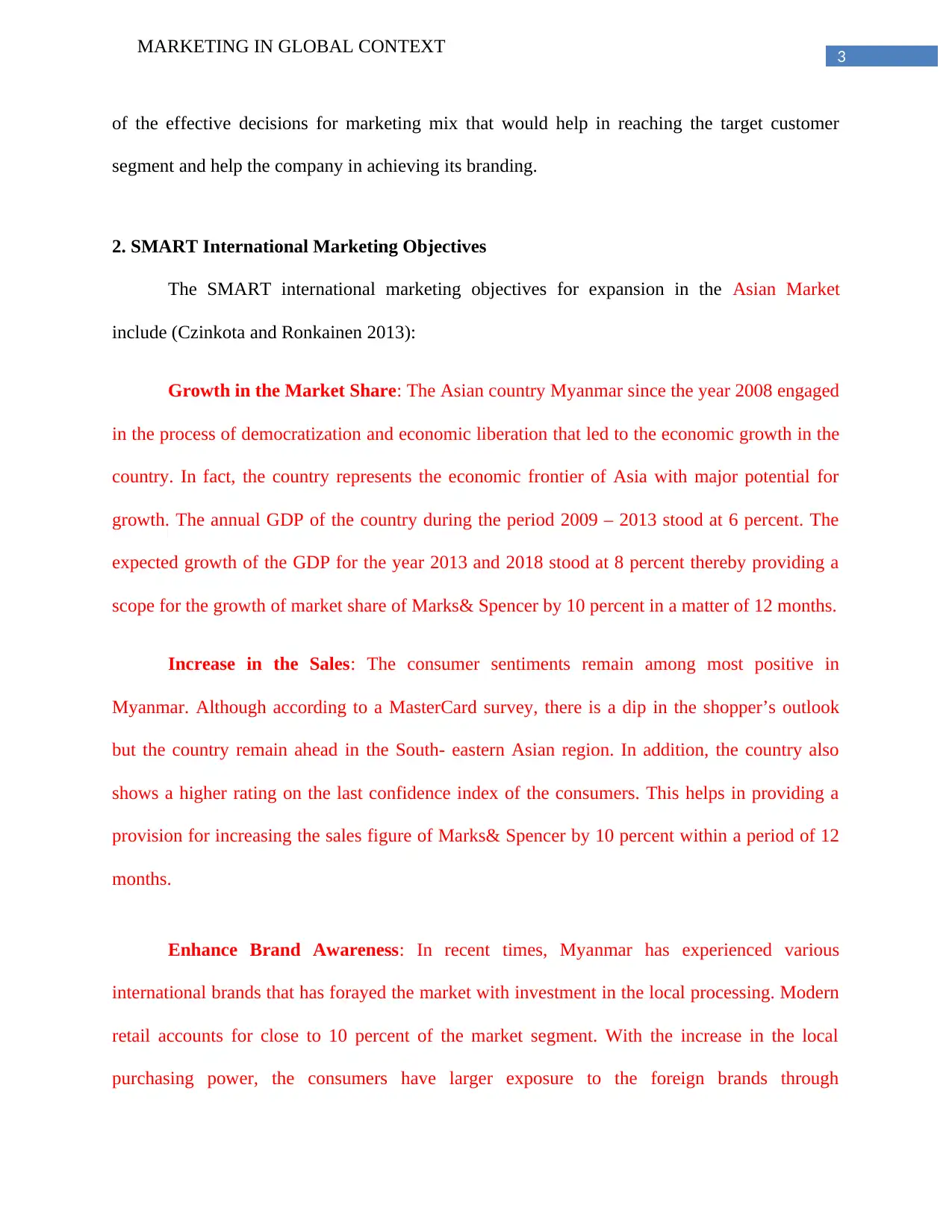
3
MARKETING IN GLOBAL CONTEXT
of the effective decisions for marketing mix that would help in reaching the target customer
segment and help the company in achieving its branding.
2. SMART International Marketing Objectives
The SMART international marketing objectives for expansion in the Asian Market
include (Czinkota and Ronkainen 2013):
Growth in the Market Share: The Asian country Myanmar since the year 2008 engaged
in the process of democratization and economic liberation that led to the economic growth in the
country. In fact, the country represents the economic frontier of Asia with major potential for
growth. The annual GDP of the country during the period 2009 – 2013 stood at 6 percent. The
expected growth of the GDP for the year 2013 and 2018 stood at 8 percent thereby providing a
scope for the growth of market share of Marks& Spencer by 10 percent in a matter of 12 months.
Increase in the Sales: The consumer sentiments remain among most positive in
Myanmar. Although according to a MasterCard survey, there is a dip in the shopper’s outlook
but the country remain ahead in the South- eastern Asian region. In addition, the country also
shows a higher rating on the last confidence index of the consumers. This helps in providing a
provision for increasing the sales figure of Marks& Spencer by 10 percent within a period of 12
months.
Enhance Brand Awareness: In recent times, Myanmar has experienced various
international brands that has forayed the market with investment in the local processing. Modern
retail accounts for close to 10 percent of the market segment. With the increase in the local
purchasing power, the consumers have larger exposure to the foreign brands through
MARKETING IN GLOBAL CONTEXT
of the effective decisions for marketing mix that would help in reaching the target customer
segment and help the company in achieving its branding.
2. SMART International Marketing Objectives
The SMART international marketing objectives for expansion in the Asian Market
include (Czinkota and Ronkainen 2013):
Growth in the Market Share: The Asian country Myanmar since the year 2008 engaged
in the process of democratization and economic liberation that led to the economic growth in the
country. In fact, the country represents the economic frontier of Asia with major potential for
growth. The annual GDP of the country during the period 2009 – 2013 stood at 6 percent. The
expected growth of the GDP for the year 2013 and 2018 stood at 8 percent thereby providing a
scope for the growth of market share of Marks& Spencer by 10 percent in a matter of 12 months.
Increase in the Sales: The consumer sentiments remain among most positive in
Myanmar. Although according to a MasterCard survey, there is a dip in the shopper’s outlook
but the country remain ahead in the South- eastern Asian region. In addition, the country also
shows a higher rating on the last confidence index of the consumers. This helps in providing a
provision for increasing the sales figure of Marks& Spencer by 10 percent within a period of 12
months.
Enhance Brand Awareness: In recent times, Myanmar has experienced various
international brands that has forayed the market with investment in the local processing. Modern
retail accounts for close to 10 percent of the market segment. With the increase in the local
purchasing power, the consumers have larger exposure to the foreign brands through
Paraphrase This Document
Need a fresh take? Get an instant paraphrase of this document with our AI Paraphraser

4
MARKETING IN GLOBAL CONTEXT
international travel and internet although the country requires more awareness with an
approximate population of 51 million. Therefore, the entry of Marks & Spencer will help in
enhancing the brand awareness by 10 percent by the end of this year.
Targeting Newer Customers: Myanmar boosts of the largest population in Southeast
Asia that is expected to rise to 56 million by the year 2020. In addition, the increase in the
customer sophistication and the growing middle class boosted the sales products like fashion
clothing, personal care, beauty and home care products. The scenario helps Marks & Spencer in
targeting the sophisticated middle and upper middle class within a period of 12 months.
Enhance Profit: The rising income in Myanmar helps fueled the consumer spending to
close to $100 billion per year. Consumers increasingly prefer newer brands thereby making way
for Mark& Spencer in earning higher revenue leading to greater profits.
Ensure Cost Control: Marks & Spencer through its entry in the Asian market can
control cost by paying less to the to the workers since the government of Myanmar has a
minimum daily wage of $2.61 which was lesser than $4.07 worker group rates desired at a
specific time.
3. Identification of Market Entry Modes
According to the APM model, the market conditions which Mark & Spencer can choose
to enter includes organic, franchise, joint venture and chain acquisition represented by the four
quadrant of the model.
MARKETING IN GLOBAL CONTEXT
international travel and internet although the country requires more awareness with an
approximate population of 51 million. Therefore, the entry of Marks & Spencer will help in
enhancing the brand awareness by 10 percent by the end of this year.
Targeting Newer Customers: Myanmar boosts of the largest population in Southeast
Asia that is expected to rise to 56 million by the year 2020. In addition, the increase in the
customer sophistication and the growing middle class boosted the sales products like fashion
clothing, personal care, beauty and home care products. The scenario helps Marks & Spencer in
targeting the sophisticated middle and upper middle class within a period of 12 months.
Enhance Profit: The rising income in Myanmar helps fueled the consumer spending to
close to $100 billion per year. Consumers increasingly prefer newer brands thereby making way
for Mark& Spencer in earning higher revenue leading to greater profits.
Ensure Cost Control: Marks & Spencer through its entry in the Asian market can
control cost by paying less to the to the workers since the government of Myanmar has a
minimum daily wage of $2.61 which was lesser than $4.07 worker group rates desired at a
specific time.
3. Identification of Market Entry Modes
According to the APM model, the market conditions which Mark & Spencer can choose
to enter includes organic, franchise, joint venture and chain acquisition represented by the four
quadrant of the model.
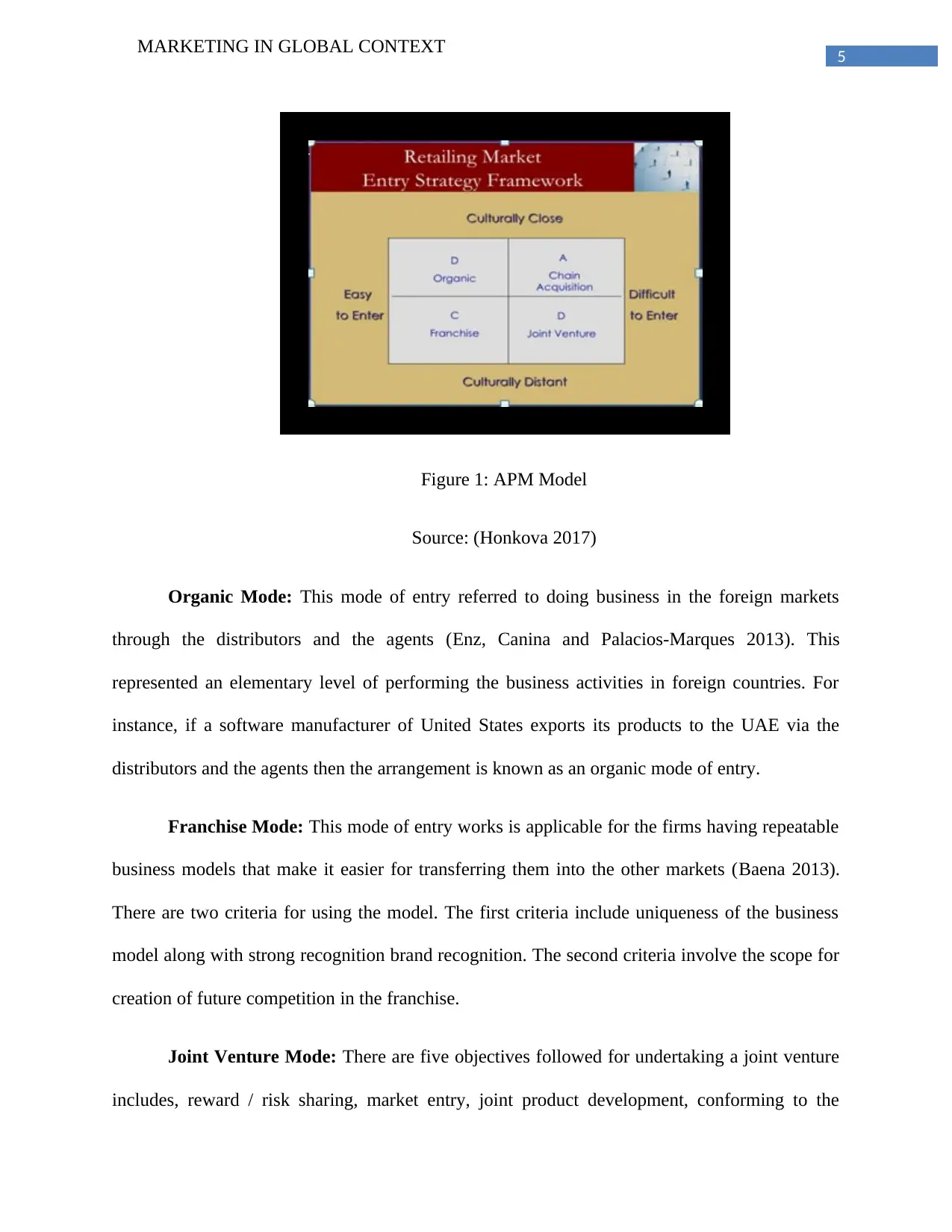
5
MARKETING IN GLOBAL CONTEXT
Figure 1: APM Model
Source: (Honkova 2017)
Organic Mode: This mode of entry referred to doing business in the foreign markets
through the distributors and the agents (Enz, Canina and Palacios-Marques 2013). This
represented an elementary level of performing the business activities in foreign countries. For
instance, if a software manufacturer of United States exports its products to the UAE via the
distributors and the agents then the arrangement is known as an organic mode of entry.
Franchise Mode: This mode of entry works is applicable for the firms having repeatable
business models that make it easier for transferring them into the other markets (Baena 2013).
There are two criteria for using the model. The first criteria include uniqueness of the business
model along with strong recognition brand recognition. The second criteria involve the scope for
creation of future competition in the franchise.
Joint Venture Mode: There are five objectives followed for undertaking a joint venture
includes, reward / risk sharing, market entry, joint product development, conforming to the
MARKETING IN GLOBAL CONTEXT
Figure 1: APM Model
Source: (Honkova 2017)
Organic Mode: This mode of entry referred to doing business in the foreign markets
through the distributors and the agents (Enz, Canina and Palacios-Marques 2013). This
represented an elementary level of performing the business activities in foreign countries. For
instance, if a software manufacturer of United States exports its products to the UAE via the
distributors and the agents then the arrangement is known as an organic mode of entry.
Franchise Mode: This mode of entry works is applicable for the firms having repeatable
business models that make it easier for transferring them into the other markets (Baena 2013).
There are two criteria for using the model. The first criteria include uniqueness of the business
model along with strong recognition brand recognition. The second criteria involve the scope for
creation of future competition in the franchise.
Joint Venture Mode: There are five objectives followed for undertaking a joint venture
includes, reward / risk sharing, market entry, joint product development, conforming to the
⊘ This is a preview!⊘
Do you want full access?
Subscribe today to unlock all pages.

Trusted by 1+ million students worldwide

6
MARKETING IN GLOBAL CONTEXT
regulations of the government and sharing of technology (Chang, Chung and Moon 2013). The
benefits include access to the distribution channels and political connections depending on the
relationship. However, such alliances become favourable when:
a. Strategic goals of the partners converge while there is diverge in competitive goals.
b. The market power and resources of the partner remains smaller compared to leaders of
the industry
c. There is a persistent ability of the partners in learning from each other while limiting
the access to the individual proprietary skills.
Chain Acquisition: Acquisition refers to the transaction where a firm is able to gain
control over another firm through the purchase of its stocks, exchange its own stocks or paying
the owners a purchase price in case of private firms (Hennart and Slangen 2015). This particular
mode is appealing since it helps the company in getting a quick and established access to the
newer market. However, while pursuing a strategy for acquisition Marks & Spencer should
examine laws of target country.
Selected Entry Mode for Securing Competitive Advantage
Marks & Spencer have chosen the Asian country market of Myanmar. The country is
however more conducive to the franchise and organic modes (Elsner 2013). The best entry mode
for Marks & Spencer would be the franchise mode for market entry in Asia since the markets of
home country is different from that of the target country.
However, this mode of entry helps Mark & Spencer in gaining a competitive advantage.
The justification is as follows (Baena 2013):
MARKETING IN GLOBAL CONTEXT
regulations of the government and sharing of technology (Chang, Chung and Moon 2013). The
benefits include access to the distribution channels and political connections depending on the
relationship. However, such alliances become favourable when:
a. Strategic goals of the partners converge while there is diverge in competitive goals.
b. The market power and resources of the partner remains smaller compared to leaders of
the industry
c. There is a persistent ability of the partners in learning from each other while limiting
the access to the individual proprietary skills.
Chain Acquisition: Acquisition refers to the transaction where a firm is able to gain
control over another firm through the purchase of its stocks, exchange its own stocks or paying
the owners a purchase price in case of private firms (Hennart and Slangen 2015). This particular
mode is appealing since it helps the company in getting a quick and established access to the
newer market. However, while pursuing a strategy for acquisition Marks & Spencer should
examine laws of target country.
Selected Entry Mode for Securing Competitive Advantage
Marks & Spencer have chosen the Asian country market of Myanmar. The country is
however more conducive to the franchise and organic modes (Elsner 2013). The best entry mode
for Marks & Spencer would be the franchise mode for market entry in Asia since the markets of
home country is different from that of the target country.
However, this mode of entry helps Mark & Spencer in gaining a competitive advantage.
The justification is as follows (Baena 2013):
Paraphrase This Document
Need a fresh take? Get an instant paraphrase of this document with our AI Paraphraser

7
MARKETING IN GLOBAL CONTEXT
Ensures Lesser Requirement of the Capital: The franchise mode of entry aids the
company in growing with the initial capital investment and further re couples the investment
necessary through the sale of the available franchises
Allows Rapid Expansion: This mode of entry allows simultaneous opening of multiple
units thereby allowing a gain of foothold over the competitors.
Business Owner in Charge: This mode of entry ensures additional responsibilities to
manager thereby demanding great deal of their effort, time and sacrifice. A franchise receives its
motivation from business ownership and capital invested.
Better Operation of the Franchise Location: Franchises run with the help of a highly
motivated owner instead of the employees. Since the capital of the owner remains at risks so,
they are motivated in performing at highest level.
Greater Power of Buying: Franchisors purchasing services and products from franchise
network often negotiates on the volume discounts from the suppliers and vendors. Thus, sharing
of a portion of savings with the franchisees helps in higher margin of operation and gaining
competitive advantage over other business.
Enhanced Recognition and Name: The presence of the additional locations will
enhance the name and recognition of the company. Franchising also allows an individual in
benefiting from collective growth and power of franchise network. This leads to higher
recognition of the name and gain in competitive advantage
Overall Strategy for Gaining Competitive Advantage
MARKETING IN GLOBAL CONTEXT
Ensures Lesser Requirement of the Capital: The franchise mode of entry aids the
company in growing with the initial capital investment and further re couples the investment
necessary through the sale of the available franchises
Allows Rapid Expansion: This mode of entry allows simultaneous opening of multiple
units thereby allowing a gain of foothold over the competitors.
Business Owner in Charge: This mode of entry ensures additional responsibilities to
manager thereby demanding great deal of their effort, time and sacrifice. A franchise receives its
motivation from business ownership and capital invested.
Better Operation of the Franchise Location: Franchises run with the help of a highly
motivated owner instead of the employees. Since the capital of the owner remains at risks so,
they are motivated in performing at highest level.
Greater Power of Buying: Franchisors purchasing services and products from franchise
network often negotiates on the volume discounts from the suppliers and vendors. Thus, sharing
of a portion of savings with the franchisees helps in higher margin of operation and gaining
competitive advantage over other business.
Enhanced Recognition and Name: The presence of the additional locations will
enhance the name and recognition of the company. Franchising also allows an individual in
benefiting from collective growth and power of franchise network. This leads to higher
recognition of the name and gain in competitive advantage
Overall Strategy for Gaining Competitive Advantage

8
MARKETING IN GLOBAL CONTEXT
The overall strategy with which Mark & Spencer can gain a competitive advantage in the
Asian market is through Porter’s generic. This is because it ensures (Tanwar 2013).
1. Cost Leadership: This strategy helps the firm in becoming the industry’s low cost
producer although the sources of the cost advantage vary depending on the industry structure.
This includes economies of the scale, access to the raw materials and the proprietary technology
in the new country. To gain cost leadership the firm must exploit and find all the sources of the
cost advantage. In the Asian market, Marks & Spencer can become an average performer if it is
able to sustain and achieve the overall cost leadership and has a command over prices there are
closer to the average of the industry.
2. Differentiation: In differentiation strategy a specific firms chooses to be unique in the
industry through some dimensions valued by the buyers. This is also true for Marks & Spencer
that has chosen the attribute of quality fashion clothing perceived by most industrial buyers and
uniquely positioning itself in meeting such needs. Such uniqueness is rewarded with a higher
price.
3. Focus: This strategy depends on the narrower competitive scope within the industry.
Here the firm chooses a group or segment and aligns their strategy in serving them. There exist
two variants of the focus strategy. The first includes the cost focus where the firm tries to seek
cost advantage from the target segment. The second includes the differentiation focus where the
firm tries to seek for differentiation in the target market. Marks & Spencer however follows the
cost focus.
4. Potential Segmentation
There are four different kinds of market segmentation are as follows:
MARKETING IN GLOBAL CONTEXT
The overall strategy with which Mark & Spencer can gain a competitive advantage in the
Asian market is through Porter’s generic. This is because it ensures (Tanwar 2013).
1. Cost Leadership: This strategy helps the firm in becoming the industry’s low cost
producer although the sources of the cost advantage vary depending on the industry structure.
This includes economies of the scale, access to the raw materials and the proprietary technology
in the new country. To gain cost leadership the firm must exploit and find all the sources of the
cost advantage. In the Asian market, Marks & Spencer can become an average performer if it is
able to sustain and achieve the overall cost leadership and has a command over prices there are
closer to the average of the industry.
2. Differentiation: In differentiation strategy a specific firms chooses to be unique in the
industry through some dimensions valued by the buyers. This is also true for Marks & Spencer
that has chosen the attribute of quality fashion clothing perceived by most industrial buyers and
uniquely positioning itself in meeting such needs. Such uniqueness is rewarded with a higher
price.
3. Focus: This strategy depends on the narrower competitive scope within the industry.
Here the firm chooses a group or segment and aligns their strategy in serving them. There exist
two variants of the focus strategy. The first includes the cost focus where the firm tries to seek
cost advantage from the target segment. The second includes the differentiation focus where the
firm tries to seek for differentiation in the target market. Marks & Spencer however follows the
cost focus.
4. Potential Segmentation
There are four different kinds of market segmentation are as follows:
⊘ This is a preview!⊘
Do you want full access?
Subscribe today to unlock all pages.

Trusted by 1+ million students worldwide

9
MARKETING IN GLOBAL CONTEXT
Demographic Segmentation: This is one of the widest as well the simplest type of
market segmentation. Maximum companies use it in getting the right kind of population for
using the products (Hamka et al. 2014). The demographic segmentation is based on the variables
such as gender, age, family size, occupation, income, race, nationality and the religion. However,
this type of segmentation is most applicable to the automobile market since it has comes in
varied price brackets.
Advantages: This type of segmentation is simple to use and apply since the statistical
data of the government is easily available for most countries. This implies cheap and quick
availability of suitable data. Segmenting through the demographics makes it easier for the most
people to understand. This ranges from the management to the sales to staffs involved in
customer service.
Disadvantages: The approach is based on the assumption that consumers within similar
demographic group will possess similar needs. This is unlikely in case of the thirty year old who
might not have same needs. Hence, the key limitation of the segmentation approach lies in the
very little understanding of consumers.
Behavioural Segmentation: This kind of segmentation of the market ensures dividing
the population based on behavior, pattern of decision-making and usage. For instance, sport
enthusiasts might not prefer the products preferred by the young people (Hjort et al. 2013). Here,
the product is marketed depending on the behavior of the individual. Behavioral segmentation is
quite common in the markets for smart phones. Marketing during the festivals is another
example of the behavioral segmentation.
MARKETING IN GLOBAL CONTEXT
Demographic Segmentation: This is one of the widest as well the simplest type of
market segmentation. Maximum companies use it in getting the right kind of population for
using the products (Hamka et al. 2014). The demographic segmentation is based on the variables
such as gender, age, family size, occupation, income, race, nationality and the religion. However,
this type of segmentation is most applicable to the automobile market since it has comes in
varied price brackets.
Advantages: This type of segmentation is simple to use and apply since the statistical
data of the government is easily available for most countries. This implies cheap and quick
availability of suitable data. Segmenting through the demographics makes it easier for the most
people to understand. This ranges from the management to the sales to staffs involved in
customer service.
Disadvantages: The approach is based on the assumption that consumers within similar
demographic group will possess similar needs. This is unlikely in case of the thirty year old who
might not have same needs. Hence, the key limitation of the segmentation approach lies in the
very little understanding of consumers.
Behavioural Segmentation: This kind of segmentation of the market ensures dividing
the population based on behavior, pattern of decision-making and usage. For instance, sport
enthusiasts might not prefer the products preferred by the young people (Hjort et al. 2013). Here,
the product is marketed depending on the behavior of the individual. Behavioral segmentation is
quite common in the markets for smart phones. Marketing during the festivals is another
example of the behavioral segmentation.
Paraphrase This Document
Need a fresh take? Get an instant paraphrase of this document with our AI Paraphraser
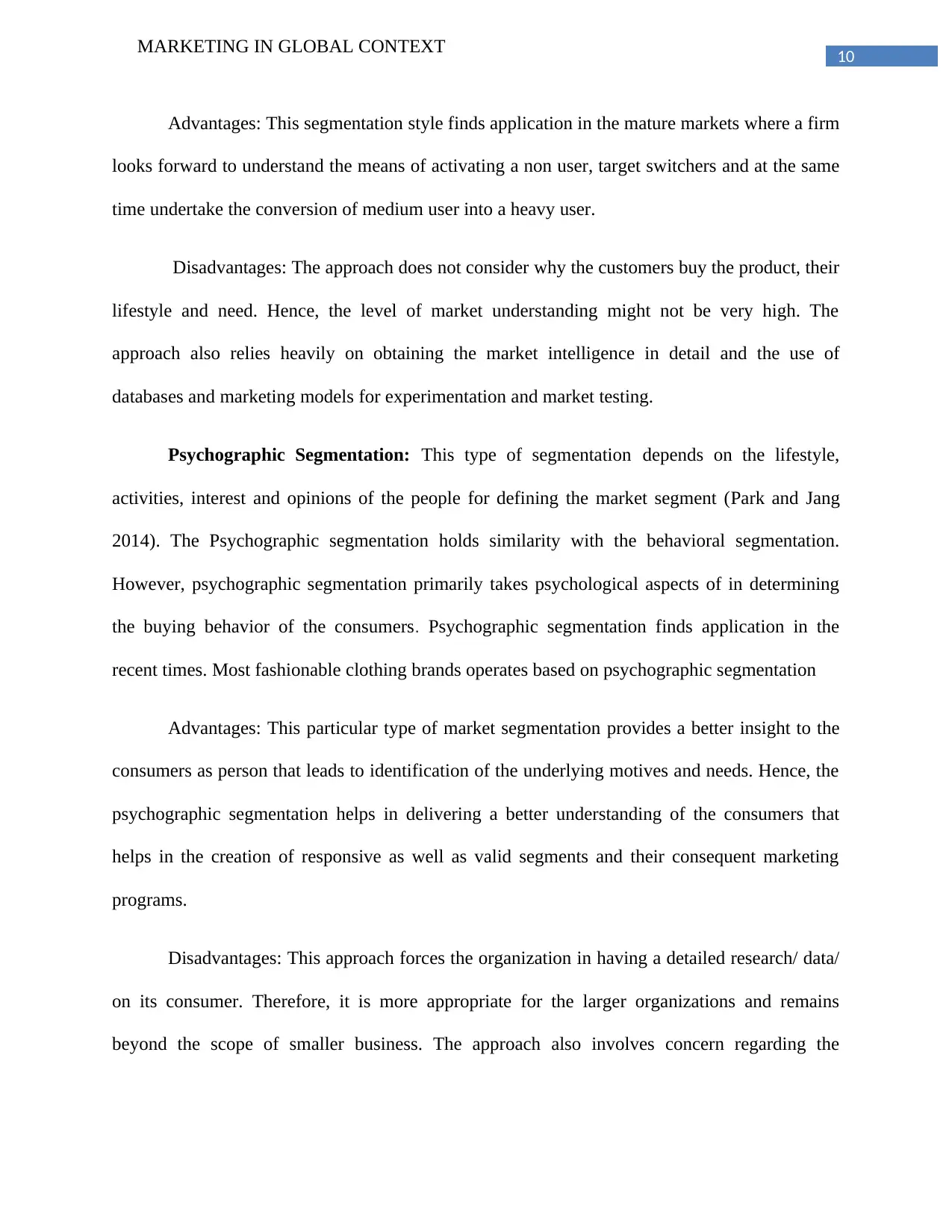
10
MARKETING IN GLOBAL CONTEXT
Advantages: This segmentation style finds application in the mature markets where a firm
looks forward to understand the means of activating a non user, target switchers and at the same
time undertake the conversion of medium user into a heavy user.
Disadvantages: The approach does not consider why the customers buy the product, their
lifestyle and need. Hence, the level of market understanding might not be very high. The
approach also relies heavily on obtaining the market intelligence in detail and the use of
databases and marketing models for experimentation and market testing.
Psychographic Segmentation: This type of segmentation depends on the lifestyle,
activities, interest and opinions of the people for defining the market segment (Park and Jang
2014). The Psychographic segmentation holds similarity with the behavioral segmentation.
However, psychographic segmentation primarily takes psychological aspects of in determining
the buying behavior of the consumers. Psychographic segmentation finds application in the
recent times. Most fashionable clothing brands operates based on psychographic segmentation
Advantages: This particular type of market segmentation provides a better insight to the
consumers as person that leads to identification of the underlying motives and needs. Hence, the
psychographic segmentation helps in delivering a better understanding of the consumers that
helps in the creation of responsive as well as valid segments and their consequent marketing
programs.
Disadvantages: This approach forces the organization in having a detailed research/ data/
on its consumer. Therefore, it is more appropriate for the larger organizations and remains
beyond the scope of smaller business. The approach also involves concern regarding the
MARKETING IN GLOBAL CONTEXT
Advantages: This segmentation style finds application in the mature markets where a firm
looks forward to understand the means of activating a non user, target switchers and at the same
time undertake the conversion of medium user into a heavy user.
Disadvantages: The approach does not consider why the customers buy the product, their
lifestyle and need. Hence, the level of market understanding might not be very high. The
approach also relies heavily on obtaining the market intelligence in detail and the use of
databases and marketing models for experimentation and market testing.
Psychographic Segmentation: This type of segmentation depends on the lifestyle,
activities, interest and opinions of the people for defining the market segment (Park and Jang
2014). The Psychographic segmentation holds similarity with the behavioral segmentation.
However, psychographic segmentation primarily takes psychological aspects of in determining
the buying behavior of the consumers. Psychographic segmentation finds application in the
recent times. Most fashionable clothing brands operates based on psychographic segmentation
Advantages: This particular type of market segmentation provides a better insight to the
consumers as person that leads to identification of the underlying motives and needs. Hence, the
psychographic segmentation helps in delivering a better understanding of the consumers that
helps in the creation of responsive as well as valid segments and their consequent marketing
programs.
Disadvantages: This approach forces the organization in having a detailed research/ data/
on its consumer. Therefore, it is more appropriate for the larger organizations and remains
beyond the scope of smaller business. The approach also involves concern regarding the
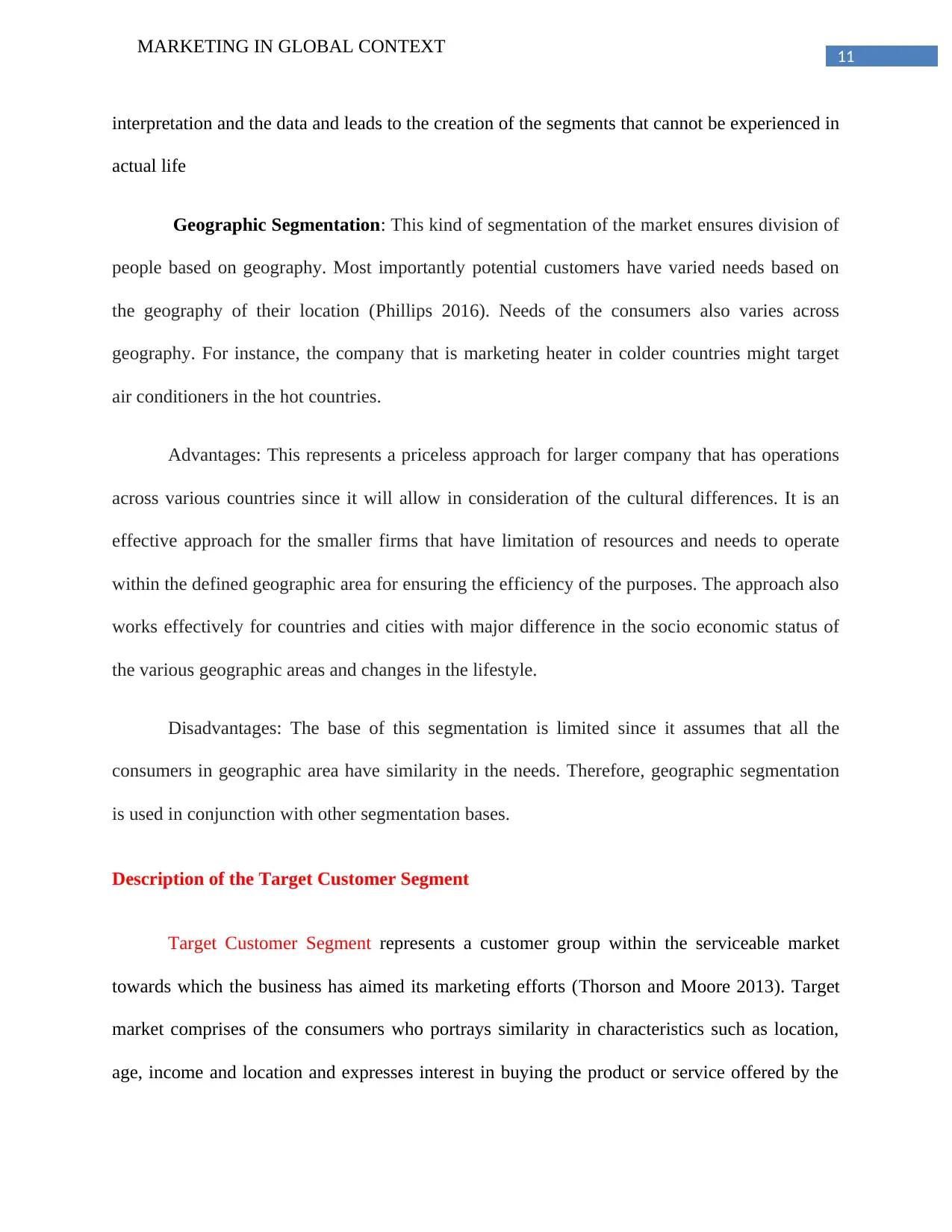
11
MARKETING IN GLOBAL CONTEXT
interpretation and the data and leads to the creation of the segments that cannot be experienced in
actual life
Geographic Segmentation: This kind of segmentation of the market ensures division of
people based on geography. Most importantly potential customers have varied needs based on
the geography of their location (Phillips 2016). Needs of the consumers also varies across
geography. For instance, the company that is marketing heater in colder countries might target
air conditioners in the hot countries.
Advantages: This represents a priceless approach for larger company that has operations
across various countries since it will allow in consideration of the cultural differences. It is an
effective approach for the smaller firms that have limitation of resources and needs to operate
within the defined geographic area for ensuring the efficiency of the purposes. The approach also
works effectively for countries and cities with major difference in the socio economic status of
the various geographic areas and changes in the lifestyle.
Disadvantages: The base of this segmentation is limited since it assumes that all the
consumers in geographic area have similarity in the needs. Therefore, geographic segmentation
is used in conjunction with other segmentation bases.
Description of the Target Customer Segment
Target Customer Segment represents a customer group within the serviceable market
towards which the business has aimed its marketing efforts (Thorson and Moore 2013). Target
market comprises of the consumers who portrays similarity in characteristics such as location,
age, income and location and expresses interest in buying the product or service offered by the
MARKETING IN GLOBAL CONTEXT
interpretation and the data and leads to the creation of the segments that cannot be experienced in
actual life
Geographic Segmentation: This kind of segmentation of the market ensures division of
people based on geography. Most importantly potential customers have varied needs based on
the geography of their location (Phillips 2016). Needs of the consumers also varies across
geography. For instance, the company that is marketing heater in colder countries might target
air conditioners in the hot countries.
Advantages: This represents a priceless approach for larger company that has operations
across various countries since it will allow in consideration of the cultural differences. It is an
effective approach for the smaller firms that have limitation of resources and needs to operate
within the defined geographic area for ensuring the efficiency of the purposes. The approach also
works effectively for countries and cities with major difference in the socio economic status of
the various geographic areas and changes in the lifestyle.
Disadvantages: The base of this segmentation is limited since it assumes that all the
consumers in geographic area have similarity in the needs. Therefore, geographic segmentation
is used in conjunction with other segmentation bases.
Description of the Target Customer Segment
Target Customer Segment represents a customer group within the serviceable market
towards which the business has aimed its marketing efforts (Thorson and Moore 2013). Target
market comprises of the consumers who portrays similarity in characteristics such as location,
age, income and location and expresses interest in buying the product or service offered by the
⊘ This is a preview!⊘
Do you want full access?
Subscribe today to unlock all pages.

Trusted by 1+ million students worldwide
1 out of 29
Related Documents
Your All-in-One AI-Powered Toolkit for Academic Success.
+13062052269
info@desklib.com
Available 24*7 on WhatsApp / Email
![[object Object]](/_next/static/media/star-bottom.7253800d.svg)
Unlock your academic potential
Copyright © 2020–2025 A2Z Services. All Rights Reserved. Developed and managed by ZUCOL.





